Sue Burke's Blog, page 25
April 19, 2021
My story at Daily Science Fiction: “Magic Rules Zero Through Four”
My flash fiction story, “Magic Rules Zero Through Four” was just published by Daily Science Fiction! Only 475 words. Read it here:
https://dailysciencefiction.com/fantasy/magic-and-wizardry/sue-burke/magic-rules-zero-through-four
In the author story comments, I talk about what led to this story:
“My favorite words are but and what if. One day I thought about the way that the laws of thermodynamics begin with zero. What if magic had rules that started with zero, too? Our understanding of thermodynamics gives us great powers, but what powers would the rules of magic give us? This story offers one answer, but what if there are better answers?”
***
My next novel, Immunity Index, goes on sale May 4.
April 15, 2021
“Myself and my circumstance”
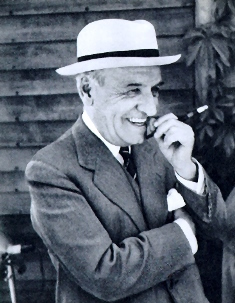 José Ortega y Gasset. Photo from Wikimedia Commons.
José Ortega y Gasset. Photo from Wikimedia Commons.My novel, Immunity Index, available next month, opens with a quote from the Spanish philosopher José Ortega y Gasset: “Yo soy yo y mi circunstancia y si no la salvo a ella no me salvo yo.” I am myself and my circumstance, and if I do not save it, I do not save myself.
It appeared in a essay in the book Meditaciones del Quijote (Meditations on Quixote) published in 1914 when he lived in Madrid, Spain. In the essay, he posits that there can be no “I” without the external world, and he contrasts freedom and fate.
I’ve translated a portion of that essay here:
***
We must look for our circumstance, such as it is, precisely in what it holds as limitation, as particularity, as the apt place in the immense perspective of the world — not to remain in constant rapture of its solemn ethos but to conquer the appropriate site for our individual life there. To be brief: the reabsorption of circumstance is humanity’s specific destiny.
My natural outlet toward the universe opens through the passes of the Guadarrama Mountains [northwest of Madrid] or the fields of Ontígola [to the southeast]. This sector of circumstantial reality forms the other half of my persona: only through it can I be integrated and be fully myself. Biological science now studies the living organism as a unit composed of the body and its particular medium: thus the vital process consists not only in the adaptation of the body to its medium but also in the adaptation of the medium to the body. The hand endeavors to shape a material object by grasping it tightly; but at the same time, each material object hides a previous affinity with a specific hand.
I am myself and my circumstance, and if I do not save it, I do not save myself. Benefac loco illi quo natus est [Bless the place where you are born], we read in the Bible. And in the Platonic school, as the enterprise of all culture, we are given this: “to save the appearances” or the phenomena. That is, looking for the meaning of what surrounds us.
With our eyes schooled by a map of the world, we ought to return to the Guadarrama Mountains. Perhaps we will find nothing profound there. But we may be sure that the shortcoming and sterility result from our gaze. There is a logos as well in the Manzanares River: this most humble rivulet, this liquid irony that moistens the groundworks of our city, beyond a doubt carries among its few drops of water a drop of spirituality.
For there is nothing in the world without a thread of divine sinew: the difficulty rests in reaching it and making it contract. Heraclitus shouted to his friends who hesitated to enter the kitchen where he was: “Come in! Come in! There are gods here too.” […]
Nothing impedes heroism — which is the activity of the spirit — as much as considering it attached to certain specific substances of life. Wherever heroism might subsist below ground, every person needs to hope that if they vigorously strike the ground beneath their feet, a spring will gush forth. For Moses, the hero, every rock was a source of water.
***
Immunity Index goes on sale May 4. You can order an autographed copy through Volumes Bookcafé.
April 8, 2021
My Goodreads review of “Middlegame” by Seanan McGuire
 Middlegame by Seanan McGuire
Middlegame by Seanan McGuireMy rating: 5 of 5 stars
Beware of alchemists, if alchemy is real in your universe. It can permit access to unlimited power, and while power might not corrupt, it can reveal deeply corrupt personalities.
This long but never slow novel centers around two people, not corrupt, who were created as a very corrupt alchemist’s experiment to manipulate the universe. What could go wrong? In Seanan McGuire’s capable hands, a lot. Human beings, even artificial ones, resist control. They will resist before they know what they are, and they will resist even harder after they find out what they can do.
From the first page, the story is told with urgent, evocative prose. “Timeline: five minutes too late, thirty seconds from the end of the world. There is so much blood.” Exactly what too late means becomes more clear as the story develops and adds successive layers of complications and depth.
This novel won major awards and nominations for a reason. It might break your heart — and it might make your heart full. Spoiler: it is not the end of the world. This time.
View all my reviews
April 5, 2021
“Semiosis” ebook only $2.99
My publisher, Tor, has made a few ebooks available at the special price of only $2.99 throughout the entire month of April:
Semiosis by Sue Burke Miranda and Caliban by Jacqueline Carey Afterparty by Daryl GregoryFind out more about the books and get links to your favorite bookseller here:
$2.99 eBook Sale: April 2021
***
My latest novel, Immunity Index, goes on sale May 4. Read an excerpt here. Read a different excerpt here.
April 1, 2021
My woolly mammoth ivory
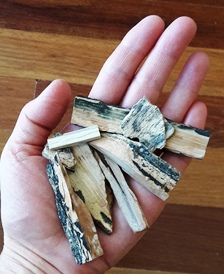
I own a few bits of woolly mammoth ivory. Although the sale of ivory from elephants is restricted and highly controversial, woolly mammoth ivory is unrestricted and provokes few worries.
That’s because elephants are listed as threatened with extinction by CITES (the Convention on International Trade in Endangered Species of Wild Fauna and Flora), and despite conservation efforts, illegal trade continues. Woolly mammoths, however, went extinct about 10,000 years ago. No mammoths are killed to obtain ivory because they’re already dead, so woolly mammoth ivory remains relatively easy to buy and somewhat affordable.
My ivory came from Alaska, and I bought it from a jeweler. He had bought a piece of tusk that came with a bark-like crust, the result of thousands of years of aging, which he’d stripped off and was selling for 25 cents per gram, since he had no use for it.
I’m not sure what I’ll do with it, either. It looks a lot like tree bark but feels and weighs more like stone, since it’s basically a mineral that our bodies can produce: a tooth. Perhaps I could use my bits to make jewelry that uses its rough aesthetics to artistic advantage.
I bought the ivory because a woolly mammoth plays a role in my latest novel — specifically, a mammoth recreated by genetic engineering. While the novel largely deals with other issues, it mentions a few of the problems with mammoth de-extinction. For example, mammoths, like elephants, led highly social lives. If we want to bring them back humanely, we need to bring back many large herds of them. In the book, sadly, that wasn’t done.
***
The latest novel, Immunity Index, goes on sale May 4. Read an excerpt here. Read a different excerpt here.
March 25, 2021
Homer’s wine-dark sea
 This is a view of Osterman Beach in Chicago from the Weatherbug weather cam website, taken on December 29, 2020, at 6:59 a.m. I can see Osterman Beach from a different angle through the window of the home office where I’m writing this.
This is a view of Osterman Beach in Chicago from the Weatherbug weather cam website, taken on December 29, 2020, at 6:59 a.m. I can see Osterman Beach from a different angle through the window of the home office where I’m writing this.***
Much has been made of the lack of the word “blue” used by Homer to describe the sea in the Illiad and the Odyssey. Instead, he often compares its color to wine.
But water is blue! So is the sky! Therefore ancient Greeks had problems with the color. Perhaps they couldn’t even see it.
To which I say: hogwash. I live next to an inland sea, Lake Michigan, and it can be a variety of colors, depending on the waves, the turbulence, and the sky. Besides many shades of blue (from pale to deep), the water can also look green, gray, brown, black (at night), and white (in winter), among other colors, sometimes several colors at once.
The sky can display a multitude of colors as well, especially at sunset and sunrise.
And so, on some wonderful mornings, water can be turned, briefly, into wine.
***
Tangentially, there’s this discussion of the color of the sea from Ulysses by James Joyce, about which I have no comment.
***
My next novel, Immunity Index, goes on sale May 4.
March 20, 2021
Three years ago today, I started writing “Immunity Index”
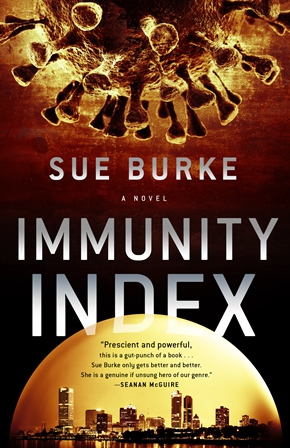
I made two mistakes when I started writing the novel Immunity Index.
The first mistake was to try “pantsing” as a writing technique — that is, to write from the seat of my pants rather than from a plan and an outline. While my first drafts are always shit (which does not make me at all like Hemingway in any other sense), this first draft was especially bad and required nine painful complete rewrites.
The second mistake was trying to tell a story set in the near future. Events in the future, like the things seen in a convex mirror, are closer than they appear.
This vision of the future, however, started back in the 1980s. As a newspaper reporter, I was covering news about AIDS, then a terrifying new disease. One evening, before a meeting, I was chatting with the Wisconsin state epidemiologist. He said that as bad as AIDS was, it could have been worse. He was a gay man, and we both knew that AIDS was already a disaster, and the disaster would keep growing.
He said, though, we were lucky that AIDS was only communicable, not actually contagious. Worse would have been a fatal illness that could be spread as easily as a cold.…
In 2018, I imagined a deadly, contagious coronavirus. It was fiction. Until it wasn’t.
My fictional story, though, is better than our shared reality. For one thing, the novel has a happy ending — and it has suspense, intrigue, adventure, and a woolly mammoth.
Immunity Index, goes on sale May 4. Publishers Weekly has a review. Read an excerpt here.
March 11, 2021
24,000 days old

I’m about 24,000 days old. Despite everything that’s happened over the last 65 years, one change in the material world stands out to me the most.
When I was born in 1955, fewer than 3 billion people lived on the Earth. According to YaleGlobalOnline, that number reached 7.8 billion in March 2020.
During my lifetime, the world population has more than doubled — and there was hardly a shortage of human beings on the planet 65 years ago. When my parents were born, there were only 2 billion people. In 1804, there was 1 billion.
We should hit 8 billion in 2023, 9 billion by 2037, and 10 billion by 2056.
I can’t imagine a billion people, but I know what population growth has meant to me — this single memory, multiplied by everywhere:
When I was eight or nine years old, my friends and I would ride our bikes from our homes in Greendale, Wisconsin, to Boerner Botanical Gardens, about three miles away. (We were free-range children.) The quiet ride took us through suburbs and past farm fields and groves of trees.
The biggest crossroads was 76th Street at Grange Avenue. Grange, a two-lane country road, had a stop sign, and 76th didn’t, but it held such scant traffic that an eight-year-old had no trouble peddling across it safely.
Less than a decade later, Southridge Mall opened at that corner, and more development followed. Now, as the photo from Google Maps shows, Grange Avenue is a four-lane boulevard plus turn lanes and 76th Street has six lanes, and the crossroad can intimidate anyone not in an SUV. The fields have been paved over. The once-quiet country road bustles day and night.
Everywhere that I’ve lived and visited, roads and buildings grow and grow endlessly.
That’s what billions more people mean to me: more cars, more pavement, and more buildings — but fewer farm fields, fewer trees, fewer kid-friendly spaces, and less peace and quiet.
***
I’ve posted a new article, “What’s a masterpiece worth?” How much did Cervantes get paid for Don Quixote of La Mancha? We don’t really know, but I try to come up with an estimate, and it jives with other estimates. He earned a pittance. Read the article here.
March 4, 2021
Read an excerpt of my next book: Immunity Index
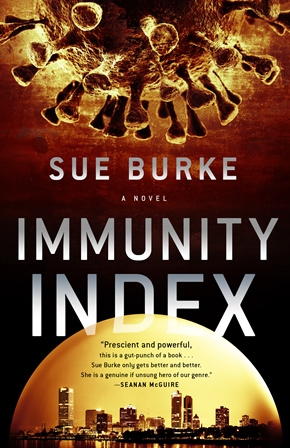
You can now read a portion of Chapter 1 of Immunity Index at the Tor/Forge blog. It will be published on May 4: https://www.torforgeblog.com/2021/02/26/excerpt-immunity-index-by-sue-burke/
It’s not a sequel to Semiosis and Interference (the sequel, Usurpation, is on the way). Instead, this is the story of separated sisters, a virus, a rebellion — and a cantankerous woolly mammoth.
February 25, 2021
Capricon 41: creating the present we wanted
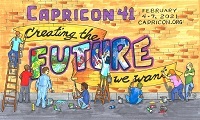
Inspired by this poem by Ross Gay: “To the Fig Tree on 9th and Christian.”
Capricon is a Chicago science fiction convention. We come together for four days in February at a hotel convention center, and we call ourselves family, except that this year we did not come.
We met alone together, hundreds of us, with cameras and keyboards, and we recreated what we could. Art, games, panels, films, freebies, kids activities, the guy in the goat costume, other people in costumes, music, and parties, some including DJs, and of course the commemorative tee-shirt. It depicted a goat wearing a face mask.
At a science fiction convention, fans and authors, scientists and singers, costumers and gamers are the same, energized by ideas and expression. We gather to share our love for our mutual passions. It’s a tradition. This the forty-first annual Capricon.
With the freedom of non-meatspace we could welcome people from Vietnam and Brazil and Jamaica and Puerto Rico and thirty-eight states, not just Chicago and those who could travel. No hugs, but we enjoyed a wider horizon and intentional inclusion. We had special early hours so distant fans could share their dinner with our breakfast. Two hundred things were offered to do over a four-day weekend, including bartenders to help you mix your own drinks at home at the evening parties. The box fort got built. Bar Fleet had its discotheque, this time not crowded to sweaty capacity.
At a Zoom panel I ran, discussing the power of the short story, a viewer in the chat box told us a three-word story when we wondered how short a short story could be. He wrote, “Hindsight is 2020.” There’s a lot to unpack in that, but I just laughed, glad to be looking back.
Our convention had a theme: “Creating the Future We Want.” We talked about the future, about how it was made, both by intention and opportunity. We considered various futures after global warming. With or without police. With or without forgiveness. With enough room for a few grudges to hold their distance. With enough closeness to fill the space with thanks.
We tried so hard to have fun, to give each other fun, to be the family again.
Next year, our theme will be music and we plan to meet at a hotel already reserved, brick and mortar, flesh and blood. Next February, we will have the future we are working now to create. Sing us in, 2022.



